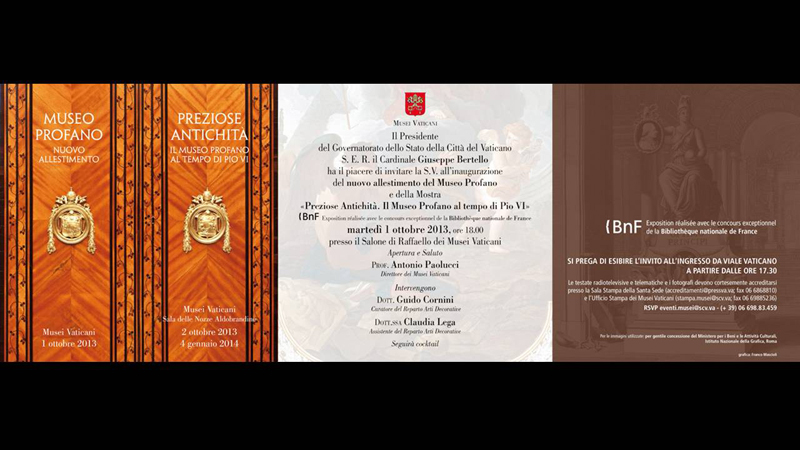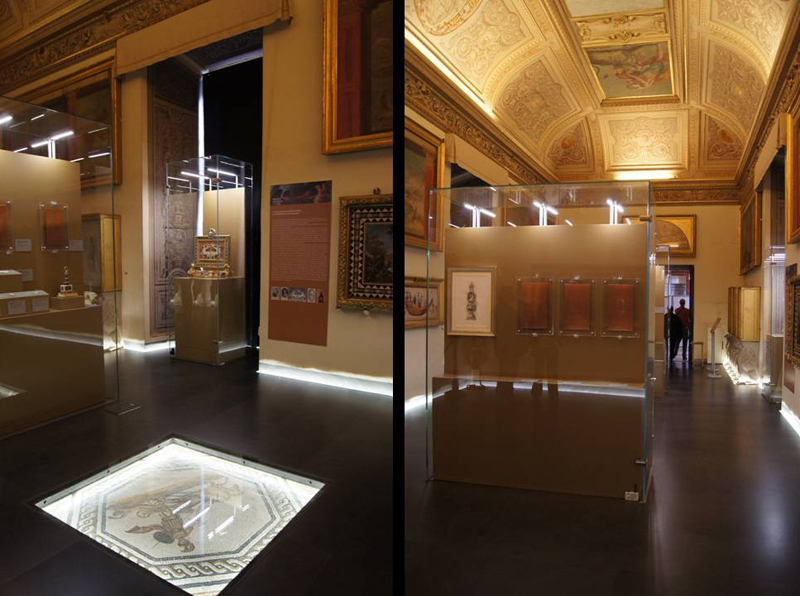Progetti

MUSEI VATICANI I ALLESTIMENTO DELLA MOSTRA
PREZIOSE ANTICHITÀ. IL MUSEO PROFANO AL TEMPO DI PIO VI
Città del Vaticano I 2012-2013 – Inaugurazione 1 Ottobre 2013
PREZIOSE ANTICHITÀ. IL MUSEO PROFANO AL TEMPO DI PIO VI
Città del Vaticano I 2012-2013 – Inaugurazione 1 Ottobre 2013
Committente: Musei Vaticani
Curatori: Guido Cornini, Claudia Lega
Progettista: Carola Gentilini Consulente scientifico per la Museografia: Pier Federico Caliari
Anche l’allestimento della mostra Preziose Antichità, inaugurata lo stesso giorno del Museo Profano, ha presentato difficoltà analoghe a quelle del Museo. La principale riguardava la location, previsto nella Sala delle Nozze Aldobrandine, in cui pareti, soffitti e pavimento sono connotati dallo presenza di opere, decorazioni e mosaici inamovibili.
E’ stata quindi pensato un allestimento “in negativo” rispetto la sintassi delle opere esposte all’interno configurando una serie di episodi espositivi interstiziali rispetto a quelli permanenti.
Per tutta la superficie della sala è stata disposta una pedana utile a distribuire le diverse alimentazioni e a proteggere il mosaico centrale con una sorta di vetrina orizzontale calpestabile. Lo spazio centrale è stato definito da due grandi teche totalmente in cristallo, prive di intelaiatura metallica e con la base annegata nella pedana (dettaglio che rende invisibile l’attacco a terra).
Le altre teche, di cui una destinata a contenere il celebre Cammeo Gonzaga, erano alte torri in cristallo inserite negli unici spazi architettonici disponibili, i grandi vani delle tre finestre presenti nella sala. Un profilo di luce a Led perimetrale, contribuiva percettivamente a staccare l’allestimento dalle murature esistenti con le loro opere.
E’ stata quindi pensato un allestimento “in negativo” rispetto la sintassi delle opere esposte all’interno configurando una serie di episodi espositivi interstiziali rispetto a quelli permanenti.
Per tutta la superficie della sala è stata disposta una pedana utile a distribuire le diverse alimentazioni e a proteggere il mosaico centrale con una sorta di vetrina orizzontale calpestabile. Lo spazio centrale è stato definito da due grandi teche totalmente in cristallo, prive di intelaiatura metallica e con la base annegata nella pedana (dettaglio che rende invisibile l’attacco a terra).
Le altre teche, di cui una destinata a contenere il celebre Cammeo Gonzaga, erano alte torri in cristallo inserite negli unici spazi architettonici disponibili, i grandi vani delle tre finestre presenti nella sala. Un profilo di luce a Led perimetrale, contribuiva percettivamente a staccare l’allestimento dalle murature esistenti con le loro opere.
Even the set up design of the Precious Antiquities exhibition, opened on the same day of the Profane Museum, presented similar difficulties to those of the Museum. The main concerned the location, provided in the famous Sala delle nozze Aldobrandini, whose walls, ceilings and floors are characterized by the presence of immovable works, decorations and mosaics. It was then thought an exhibition set up as a “negative” than the syntax of the works within configuring a series of exhibition episodes “between” permanent ones. On the whole walk surface, a platform was placed useful to distribute the different power supplies and to protect the central mosaic with a sort of horizontal showcase walkable. The central space is defined by two large showcases in glass and totally free of metal casing and with the base embedded in the platform (detail that makes invisible the ground joint).
The other showcases, one to contain the famous Gonzaga Cameo, were high crystal towers inserted in the unique architectural spaces available, the large courtyard of the three windows opened on the museum couryards. A light led profile perimeter, helped to apart the set up from the existing walls with their works.
The other showcases, one to contain the famous Gonzaga Cameo, were high crystal towers inserted in the unique architectural spaces available, the large courtyard of the three windows opened on the museum couryards. A light led profile perimeter, helped to apart the set up from the existing walls with their works.










